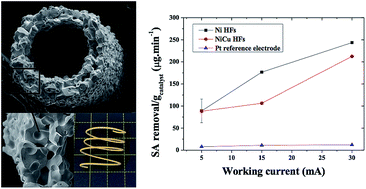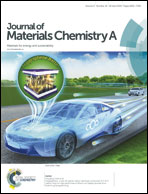Catalytic nickel and nickel–copper alloy hollow-fiber membranes for the remediation of organic pollutants by electrocatalysis†
Abstract
Electrocatalytic membrane reactors are becoming a viable solution for the treatment of wastewater contaminated with persistent organic pollutants and compounds. The development of suitable membrane elements made of abundant and stable electrocatalytic materials remains a challenge to enable durable and large-scale operation. In this study, novel nickel (Ni) and nickel-copper (NiCu) alloy hollow-fiber (HF) membranes were synthesized for the first time and used for the electrocatalytic degradation of small organic molecule pollutants from model wastewater effluents. The novel porous metal HFs were characterized and tested for their capacity to degrade salicylic acid (SA) molecules by electrochemical oxidation. The degradation of SA was monitored in situ and over time using an ultraviolet-visible (UV/vis) quartz cell. The HF membranes were found to be highly stable and reusable while the kinetics of SA electro-oxidation were 9 to 20 times greater than with pure platinum wire electrodes. The high performance of the HF materials was attributed to the interconnected pore structure combined with the natural surface reactivity and excellent electron transport properties of the Ni metal and bare NiCu alloy.



 Please wait while we load your content...
Please wait while we load your content...